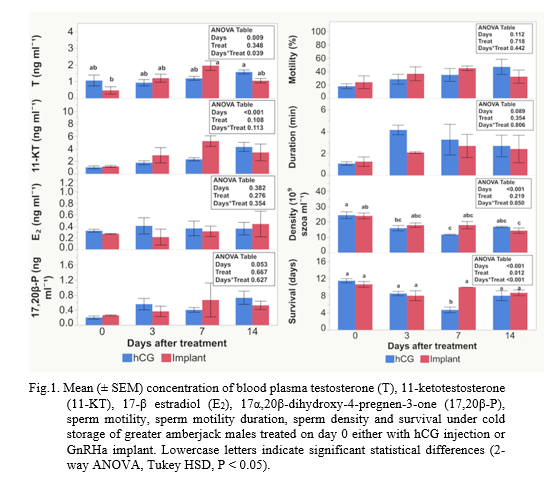SPERMIATION ENHANCEMENT OF GREATER AMBERJACK Seriola dumerili IN RESPONSE TO GnRHa IMPLANTS OR hCG
Introduction
The greater amberjack (Seriola dumerili) is a species with high potential for the diversification of the aquaculture production, due to its excellent flesh quality and high worldwide consumer acceptability. However, reproductive dysfunctions in captivity have been observed in males, even more pronounced than in females (Zupa, et al., 2017). Additionally, sperm quality and quantity were not different after rearing in sea cages or in land-based tanks, but showing remarkable decreased milt production compared to the wild (Fakriadis, Mylonas, 2021). Agonists of gonadotropin-releasing hormone (GnRHa) and human chorionic gonadotropin (hCG) have been used to overcome these problems in many fishes, and the present study compared these hormonal spermiation enhancement methods in terms of plasma sex steroid production and sperm quality.
Materials and methods
Wild-captured breeders (11.6-20.0 kg) were kept in Aqualabs, Institute of Marine Biology, Biotechnology and Aquaculture, Hellenic Centre for Marine Research, Heraκlion, Crete, Greece, in a 40 m3 tank under simulated photoperiod and temperature profile, and were fed with a broodstock diet (Skretting, Vitalis Cal, 22mm). Males, after blood and sperm collection, were treated either with a GnRHa implant (n=3) with an effective dose of 59±2 µg GnRHa kg-1 or hCG injection (n=4) with an effective dose of 617±46 IU kg-1 (day 0). Fish were sampled again for blood and sperm on day 3, 7 and 14 after the hormonal treatments. Plasma testosterone (T), 11-ketotestosterone, 17-β estradiol (E2) and 17α,20β-dihydroxy-4-pregnen-3-one (17,20β-P) were quantified with the use of enzyme-linked immunosorbent assays (ELISAs). Sperm quantity was evaluated according to their spermiation condition –which is a measure of the available milt in the testes- after gentle abdominal pressure was applied, determined by a subjective scale from 0 to 3, as follows: Spermiation index S0 = no milt released, S1= only a drop of milt released after multiple stripping attempts, S2= milt was released easily after the first stripping attempt and S3= copious amounts of milt released with very little pressure. The sperm quality parameters that were evaluated included: (a) sperm density (number of spermatozoa ml-1 of milt), (b) survival of spermatozoa under cold storage at 4°C (spermatozoa survival, days), (c) initial percentage of spermatozoa showing forward motility immediately after activation (spermatozoa motility, %) and (d) duration of forward spermatozoa motility of ≥5% of the spermatozoa in the field of view (motility duration, min).
Results and discussion
Males did not release sperm after abdominal pressure on day 0. Half of the fish (n = 2) after hCG treatment were in S2 on day 3 and S3 on day 14 after treatment, while one fish was found to be in S2 3 days after treatment with GnRHa implants. Plasma T concentration increased significantly 7 days after treatment with GnRHa implants while it did not differ significantly after treatment with hCG (Figure 1), while 11-KT also increased significantly, but there was no difference between the different treatments. Both E2 and 17.20β-P did not differ significantly after treatments. Hormonal therapies did not affect significantly sperm motility and motility duration. Sperm density decreased significantly 3 days after hCG treatment, and remained decreased on day 7, but recovered to baseline on day 14 after treatment. Treatment with GnRHa implants caused a significant reduction in sperm density 14 days after treatment. Regarding the survival of sperm under cold storage, a significant reduction was observed 7 days after hCG treatment, while no changes were observed after treatment with GnRHa implants.
References
Fakriadis, I., Mylonas, C.C., 2021. Sperm quality of greater amberjack Seriola dumerili throughout the reproductive season and in response to GnRHa treatment with controlled release implants. Fish Physiol Biochem. 47, 281-292.
Zupa, P., Fauvel, C., Mylonas, C.C., Pousis, C., Santamaría, C.A., Papadaki, M., Fakriadis, I., V., C., 2017. Rearing in captivity affects spermatogenesis and sperm quality in greater amberjack, Seriola dumerili (Risso, 1810). J. Anim. Sci. 95, 4085-4100.
